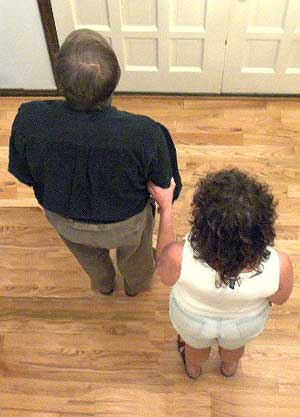Walking with a Human or Dog Guide
When walking indoors or outdoors, individuals who are blind or have low vision may choose to use the assistance of a guide, whether it’s a human or a guide dog. While friends or family members may instinctively offer help in ways that feel natural, such as holding hands or resting a hand on their shoulder, these methods can be unsafe. This guide provides valuable tips for walking with a human guide, ensuring safety and comfort, and important insights into working with a guide dog. This highly trained mobility aid offers independence and companionship.
Walking with a Human Guide
Often, people who are blind or low vision choose to use assistance when walking outside familiar environments. Perhaps a friend or family member may try to help by holding your hand or having you rest your hand on their shoulder.
While well intended, these methods are unsafe and can lead to accidents. The following skills are designed to help you and your guide maximize safety and efficiency when walking together.
How can I walk more comfortably and effectively with a guide?
Sometimes, you find it faster and easier to get somewhere by walking with another person who will act as a “guide.” The following tips can be helpful if you use a guide to help you walk to your mailbox, visit a neighbor, or shop in a mall or grocery store.

1. Hold the guide’s arm just above the elbow, like holding a glass of water or a soda can (credit: Dona Sauerburger). The thumb is on the outside of the guide’s arm, and the fingers are on the other side, nearer the guide’s body). This grip will provide the most feedback from the guide’s movements.
2. The grip should be firm enough so you don’t lose contact with the guide but not so firm that the guide is uncomfortable.
3. If you use a cane, take the guide’s arm with your free hand.
4. Tell the guide if their pace is too fast for you.
5. Follow the guide’s movements and stay half a step behind the guide when you walk together. Keeping your elbow close to your body is a good way to do this.
6. If you walk in this position instead of side-by-side, you will have time to react to hazards or obstacles in your path.
7. Instruct your guide to approach curbs and steps head-on, rather than at an oblique angle, so that you know where to expect the edge of the curb or step in relation to your guide’s and your own body.

8. Remember that it usually requires training and practice to follow the movement of your guide to anticipate steps and stairs, especially if you have some useful vision.
10. If you are approaching a narrow space, your guide should signal the change by moving their hand behind the back. You then move directly behind your guide and slide your hand down to the guide’s wrist.
11. When approaching a drop-off, your guide should stop with their toes close to the drop-off and announce: “Curb up” or “Stairs going down.” Then, the guide should step forward and allow you to find the stairs or curb with your toes. If there is a handrail, your guide should always position you on the side of it and let you know where it is so you may use it.
12. When going through a door, you will need to know two things from your guide: a) Does the door open to the right or the left? and b) Does the door open out or in? If the door opens on the right, you should be on the guide’s right side. If the door opens on the left, you should be on the guide’s left side. This may require a change of sides.
13. When you have reached your destination, ask your guide to always leave you in contact with a landmark, such as a chair, table, or wall, and not leave you alone in an “open” space.
14. An orientation and mobility (O&M) specialist can teach you additional techniques and signals you and your guide can use to walk through doorways and single-file through narrow spaces.
Tips for the Guide
Here are some tips every human/sighted guide should know:
1. When approaching someone who is blind or low vision and appears to need help, ask, “Do you need assistance?” Do not assume the person needs help. Typically, people who are blind or low vision know where they are going and do not need assistance.
2. If the person does need assistance, touch the back of your hand to the back of the person’s hand. (Announce that you are going to do this first.) This gives the person an idea of where your arm is located.
3. Ask, “Where do you need to go?”
4. Do not leave the person you’re guiding in the middle of an open area; guide them to a specific destination of their choice (table, chair, entrance, etc.).
5. Act as the person’s eyes. Remember, they are counting on you to provide accurate environmental information. Announce obstacles, such as a curb, stairs, or other danger points, before getting to them.
6. Remember to check over your shoulder on the side the person is walking on and be aware of potential obstructions and other danger points.
Walking with a Dog Guide
We’re all familiar with the image of dogs guiding people who are blind or have low vision along streets and in public spaces. But unless you’ve benefited from one of these specially-trained animals, you probably have no idea what excellent mobility tools and loving companions they can be.
The guide dog is a “mobility aid” that can act as a tool for people who are blind or have low vision to travel safely. Guide dogs can guide people around obstacles and through crowds, stop at curbs and stairs, and find a limited number of objects that are within sight when asked, such as “Find the chair,” “Find the door,” or “Find the elevator.” The guide dog user can also train (or “pattern”) the dog to find frequently used landmarks, such as a bus stop pole or a mailbox.
What Are Some Common Misconceptions About Guide Dogs?
One common misconception is that orientation and mobility (O&M) travel skills aren’t necessary if one uses a guide dog to travel safely and independently; people mistakenly assume the dog shows the person where to go. This is not true. The person who is blind or has low vision directs the dog; the dog then guides the person around obstacles and indicates the location of steps and curbs.
Another misconception is that guide dogs indicate when it is safe to cross the street. This is also not true. For example, the guide dog does not know when a traffic light changes from green to amber to red. The person (handler) determines when it is safe to cross the street and which way to go; the dog then guides the person across the street to reach the other side. Although the dog does not know when it is safe to cross the street, if it sees a car approaching too close, it has been trained to stop or attempt to move the person out of the way.
You Need Mobility Basics
Even if you plan to use a guide dog to assist you during travel, you need to know mobility basics first. Contrary to common belief, a guide dog doesn’t know where you want to go until you direct him. He understands basic commands such as “right,” “left,” or “find the door” and can learn to recognize places you visit frequently, but you must be able to judge traffic by sound, able to remember how many blocks you need to walk, and when you have to turn a corner.
Is a Guide Dog Right for You?
To obtain a guide dog, you must attend a guide dog school that will assign you a dog and train you to take care of the dog and use it to guide you. All reputable dog guide schools require that applicants demonstrate that they have the skills necessary to travel independently with a cane, including walking safely and efficiently in familiar areas, crossing streets, finding destinations, and being able to problem-solve when disoriented or lost.
Be aware that dog guides are not for everyone. Two things to keep in mind if you’re considering a dog guide are:
• High maintenance: Dog guides require daily care. They must be fed, relieved, groomed, and given regular exercise and affection.
• Use it or lose it: Dog guides must perform daily mobility tasks. While scientifically bred and highly trained, the animals will lose their skills without constant practice.
Should I Use a Guide Dog?
VisionAware Peer Advisor DeAnna Quietwater Noriega offers the following advice.
If you enjoy the company of a dog and don’t see caring for the dog as a burden, a guide dog might be the right choice for you. You take the dog outside multiple times daily, pick up waste, groom, feed, and carry items to make them comfortable. In exchange, you will have a friend by your side willing to use their vision to help you prevent falls, avoid traffic, locate doors and curbs, and dodge overhanging branches.
External Resources for Finding, Training, and Living with a Dog Guide
Guide Dog Resources | American Council of the Blind (acb.org) provides a list of guide dog schools, guide dog organizations, and sources for obtaining dog supplies.
• The National Association of Guide Dog Users (NAGDU) is an affiliate of the National Federation of the Blind and an organization for blind people who currently use guide dogs as mobility tools, those considering getting a guide dog, or those who want to learn more about the use of such dogs. NAGDU provides a forum for people interested in the guide dog movement to discuss common issues and increase opportunities for those who have chosen to use a guide dog for independent travel.
• Guide Dog Users, Inc., an affiliate of the American Council of the Blind, is an international organization dedicated to advocacy, peer support, public education, and all aspects of training, working, and living with dogs specially trained to guide people who are blind or have low vision.
• Guide Dog Handlers All Ways is a special interest alumni affiliate of Guide Dogs for the Blind. They sponsor an alumni chapter of individuals with disabilities in addition to blindness and low vision.